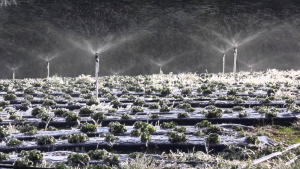
Using sprinkler irrigation for frost protection is a common method, especially for high-value crops like fruit trees, berries, and vegetables. Here’s a breakdown of what to consider, along with other options, plus pros and cons.
️ Sprinkler Irrigation for Frost Protection: What to Consider
✅ Key Considerations:
-
Application Rate:
Must apply enough water continuously to counteract evaporative cooling and keep the plant temperature above critical levels. Typical rates: 0.1–0.2 inches/hour. -
Timing:
Start sprinkling before temperatures drop below freezing (32°F / 0°C) and do not stop until ice melts off plants, or you risk more damage. -
Water Supply:
Requires a reliable, high-capacity water source, often 20–40 GPM per acre depending on system and crop. -
System Type:
-
Overhead impact sprinklers are most common.
-
Solid-set systems or portable aluminum pipe systems are typically used.
-
Uniform distribution is crucial.
-
-
Wind Speed & Humidity:
-
Works best in low wind, high humidity conditions.
-
Less effective or even harmful in dry, windy conditions due to rapid evaporation and cooling.
-
-
Crop Sensitivity & Growth Stage:
Know your crop’s critical damage temperatures, which vary by species and stage of development.
Other Frost Protection Methods
1. Wind Machines (Frost Fans)
-
Function: Mix warmer air aloft with cold surface air.
-
Best Use: On radiation frost nights with temperature inversion.
2. Heaters (Orchard Smudge Pots or Propane Heaters)
-
Function: Add heat to the air.
-
Expensive to operate and often used in combination with fans.
3. Row Covers / Blankets
-
Function: Trap ground heat near the plant.
-
Effective for low-growing crops and small operations.
4. Foggers / Humidifiers
-
Reduce radiative heat loss, but less common and location-specific.
Pros & Cons of Sprinkler Frost Protection
| Pros | Cons |
|---|---|
| ✔️ Proven effective for many crops | ❌ High water use |
| ✔️ Can protect large areas | ❌ Must run continuously once started |
| ✔️ Dual-purpose: used for irrigation and frost | ❌ Risk of damage if stopped too soon |
| ✔️ Can be automated | ❌ Not effective in windy, low-humidity conditions |
| ✔️ Cost-effective compared to heaters | ❌ Infrastructure investment required |



